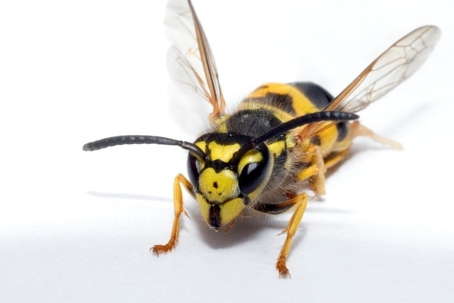Can Wasps Bite?
Yes, wasps can bite, but their primary mode of defense and offense is through stinging, not biting. Wasps have specialized mouthparts called mandibles that are designed for chewing and manipulating food, but they are not adapted for biting in the way that many other insects, such as ants or mosquitoes, do. Wasps primarily use their mandibles for tasks like constructing their nests and feeding on various sources of protein, such as insects and other arthropods.
When wasps feel threatened or provoked, they are more likely to use their stingers, which are modified ovipositors (egg-laying structures) found in female wasps. These stingers are equipped with venom that they inject into their target when they sting. This venom can cause painful reactions in humans, ranging from localized pain and swelling to severe allergic reactions in some individuals.
It's essential to exercise caution around wasps and avoid provoking them to prevent stings, as their stings can be quite painful and, in some cases, dangerous. While they may bite in certain situations, their primary means of defense and attack is their stinger.
Do Wasps Bite?
Rather than use their mandibles for biting, wasps primarily use their stingers as a defense mechanism. When wasps feel threatened or perceive a potential threat to their nest or themselves, they may sting as a defensive response. Here's a more information about wasp stings:
- Stinger Structure: Female wasps have a modified ovipositor, which is a long, pointed structure at the rear of their abdomen. This modified ovipositor functions as a stinger. It consists of a needle-like tube with a venom sac attached.
- Venom: When a wasp stings, it injects venom from its venom sac into the victim. This venom is a mixture of proteins and other compounds designed to immobilize or deter potential threats.
- Pain and Allergic Reactions: Wasp stings are known for causing immediate pain, redness, and swelling at the sting site. Some individuals may experience more severe reactions, including allergic responses. Anaphylaxis is a severe allergic reaction that can be life-threatening and requires immediate medical attention.
- Multiple Stings: In some cases, wasps can sting multiple times. Unlike honeybees, which have barbed stingers that become embedded in the skin, wasps can withdraw their stingers and sting again.
Wasps play essential roles in ecosystems by controlling insect populations, so it's generally best to coexist with them peacefully and take precautions to minimize the risk of stings when necessary.
Wasp Bites
When people talk about “wasp bites,” they’re usually referring to the rare occasions when a wasp uses its mandibles to pinch the skin instead of— or in addition to— delivering a venomous sting. Unlike stings, bites don’t inject venom, so the risks are generally far milder. Still, a wasp bite can be uncomfortable, and in certain situations it can lead to a few problems worth knowing about.
A wasp bite typically causes sharp, momentary pain followed by localized redness, mild swelling, and slight irritation at the site. Because no venom is involved, most symptoms fade quickly and don’t progress. However, the bite can break the skin enough to create a small abrasion or puncture, which introduces a minor risk of bacterial infection if the area isn’t kept clean. People with very sensitive skin may also experience more noticeable swelling or itching.
Although true allergic reactions are nearly always tied to venom from stings, not bites, an individual who is extremely sensitive might still experience exaggerated inflammation in the bitten area. This is rare and generally limited to localized discomfort rather than systemic symptoms.
What Do Wasp Bites Look Like?
Technically, wasps don’t bite humans in the same way that some insects do—such as mosquitoes or horse flies. Instead, they primarily sting using a venomous stinger located at the end of their abdomen. However, wasps do have mandibles (jaws), and they sometimes use them to bite in non-defensive situations, such as:
Tearing food or nesting material (e.g., wood fibers for paper wasps’ nests).
Defending their nest, when they may grasp or pinch skin with their mandibles before stinging.
Holding onto prey while delivering a sting.
If a wasp does manage to “bite” or pinch a person with its mandibles, the mark is usually minor and superficial. It can look like:
A small red dot or tiny scratch, similar to a mild insect pinch.
Occasionally, a faint welt or slight swelling if the skin is sensitive.
There’s no venom involved, so it won’t produce the burning pain or raised, itchy bump typical of a sting.
A wasp sting leaves a red, swollen bump with a central puncture mark, and it usually burns or itches due to venom injection.
What To Do About Wasp Bites
If a wasp bites you rather than stings you, the steps you should take are straightforward, because a bite doesn’t involve venom and usually causes only minor, short-lived irritation. Even so, proper care helps prevent discomfort and reduces the risk of infection.
Start by washing the bite area thoroughly with soap and warm water. A wasp bite can create a small break in the skin, so cleansing helps remove bacteria and lowers the chance of a secondary infection. After cleaning, a cold compress or ice pack wrapped in cloth can ease pain, reduce redness, and keep swelling down.
If the area feels itchy or continues to bother you, an over-the-counter hydrocortisone cream or an oral antihistamine can calm irritation. These aren’t always necessary, but they can make the healing process more comfortable.
Keep an eye on the site for the rest of the day. Because bites don’t deliver venom, serious reactions are extremely unlikely, but you should still watch for signs of infection such as spreading redness, increasing pain, warmth, or the development of pus. If any of those symptoms appear, or if irritation worsens instead of fading, it’s a good idea to reach out to a healthcare professional.

